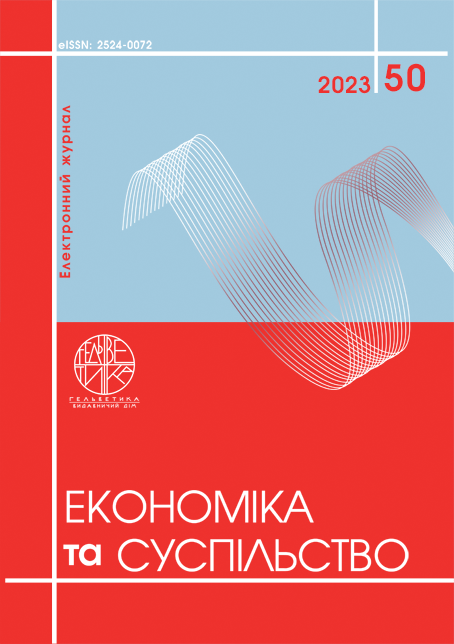MODERN APPROACHES TO COMPETITIVENESS ASSESSMENT IN HIGHER EDUCATION
Abstract
The purpose of the study is a critical analysis of modern methods assessment competitiveness of universities and their educational services, systematization influencing factors by relations types (B2B, B2C, B2G, C2C) and from the point of view all stakeholders in higher education. The technological revolution reformatted the educational process, and the pandemic accelerated the introduction of innovative training technologies. The influence of such factors as the digitization educational processes, the education openness, the economy of shared knowledge, the providing of short-cycle educational services, the introduction of microcredits and nanodiplomas is causing fundamental transformation changes on the educational services market. These factors, along with adverse demographic changes, justify the need to revise both the competitive strategy of universities and modern approaches to assessing their competitiveness. Increasingly, the educational services market is witnessing an intensification competition not only between "traditional" universities, but also other providers educational services. The market boundaries have become less clear, which requires making adjustments to the definition capacity and market share. The composition of influencing factors on the universities’ competitiveness and their educational services has changed qualitatively and quantitatively. Traditionally, the main method of assessing competitiveness in the educational sphere was and continues to be the universities’ ranking. A comparative analysis of modern rating methods of Academic Ranking of World Universities, Times Higher Education World University Rankings and QS World University Rankings was conducted, their common and distinctive features were determined. However, the wide range of stakeholders educational process doesn’t allow to consider rating as a universal evaluation method. The study proposes a systematization criteria for competitiveness evaluating universities/educational services by relations type (B2B, B2C, B2G, C2C) and from the point of view of all stakeholders. The application features such modern methods as SWOT-, SOAR-, STEP-, PESTEL-, NOISE-analysis and determining market share for evaluating competitiveness of providers educational services are considered.
References
Sophie Ashcroft. (2021). Risk Management in Digital Transformation for Universities. https://www.brownejacobson.com/insights/risk-management-in-digital-transformation-for-universities.
Ulf-Daniel Ehlers (2019). Future Skills. Lernen der Zukunft – Hochschule der Zukunft. DOI: https://doi.org/10.1007/978-3-658-29297-3
Academic Ranking of World Universities (ARWU). Retrieved from: https://www.shanghairanking.com/news/arwu
Times Higher Education World University Rankings. Retrieved from: https://www.timeshighereducation.com/world-university-rankings
QS World University Rankings. Retrieved from: https://www.topuniversities.com/qs-world-university-rankings
John Davis, Mark Farrell. How Seismic Changes in the Higher Education Landscape Will Impact Universities. Retrieved from: https://www.dukece.com/insights/how-seismic-changes-higher-education-landscape-will-impact-universities/
Douglas C. Bennett. Assessing Quality in Higher Education. Retrieved from: https://www.aacu.org/publications-research/periodicals/assessing-quality-higher-education
About competitiveness. Retrieved from: https://www.cleverism.com/skills-and-tools/competitiveness
Lebherz Carmen, Mohr, Cordula, und an. (2005). Wie brauchbar sind Hochschul-Rankings? Eine empirische Analyse Teichler, Ulrich [Hrsg.]; Tippelt, Rudolf [Hrsg.]: Hochschullandschaft im Wandel. Weinheim u.a. : Beltz 2005, S. 188-208. - (Zeitschrift für Pädagogik, Beiheft; 50).
Significant Risks Facing Higher Education. (2018). Retrieved from: https://www2.deloitte.com/content/dam/Deloitte/us/Documents/public-sector/us-top-risks-higher%20education-up-digital.pdf
Sophie Ashcroft (2021). Risk Management in Digital Transformation for Universities. Available at: https://www.brownejacobson.com/insights/risk-management-in-digital-transformation-for-universities
Ulf-Daniel Ehlers (2019). Future Skills. Lernen der Zukunft – Hochschule der Zukunft. DOI: https://doi.org/10.1007/978-3-658-29297-3
Academic Ranking of World Universities (ARWU). Available at: https://www.shanghairanking.com/news/arwu
Times Higher Education World University Rankings. Available at: https://www.timeshighereducation.com/world-university-rankings
QS World University Rankings. Available at: https://www.topuniversities.com/qs-world-university-rankings
John Davis, Mark Farrell. How Seismic Changes in the Higher Education Landscape Will Impact Universities. Available at: https://www.dukece.com/insights/how-seismic-changes-higher-education-landscape-will-impact-universities/
Douglas C. Bennett. Assessing Quality in Higher Education. Available at: https://www.aacu.org/publications-research/periodicals/assessing-quality-higher-education
About competitiveness. Available at: https://www.cleverism.com/skills-and-tools/competitiveness
Lebherz Carmen, Mohr Cordula, und an. (2005). Wie brauchbar sind Hochschul-Rankings? Eine empirische Analyse Teichler, Ulrich [Hrsg.]; Tippelt, Rudolf [Hrsg.]: Hochschullandschaft im Wandel. Weinheim u.a. : Beltz 2005, S. 188-208. - (Zeitschrift für Pädagogik, Beiheft; 50).
Significant Risks Facing Higher Education (2018). Available at: https://www2.deloitte.com/content/dam/Deloitte/us/Documents/public-sector/us-top-risks-higher%20education-up-digital.pdf

This work is licensed under a Creative Commons Attribution 4.0 International License.


